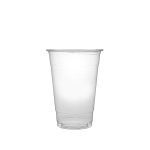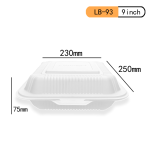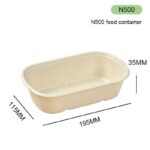This article compares rPET, PET, CPET, and PLA food packaging materials, exploring their benefits, sustainability, and ideal uses. rPET and PET are cost-effective and durable, ideal for cold food and beverages, while CPET excels in heat-resistant packaging for microwavable meals. PLA, made from renewable resources, offers eco-friendly options but has limitations with heat resistance. The article helps businesses choose the best material based on food type, sustainability goals, and cost.
In recent years, there has been a growing demand for sustainable food packaging as consumers become more environmentally conscious and industries work towards minimizing their environmental impact. When it comes to food packaging materials, rPET, PET, CPET, and PLA are among the most commonly used materials. Each material has distinct advantages and applications, making them suitable for different types of food packaging.
In this article, we will explore and compare rPET, PET, CPET, and PLA food packaging, highlighting their properties, benefits, sustainability, and suitability for various types of food. This comparison will help businesses in the food service and packaging industries make informed decisions about which material best aligns with their goals of sustainability, cost-effectiveness, and food safety.

Understanding rPET, PET, CPET, and PLA
Before we compare these materials, it’s important to first understand what each material is and its key features.
rPET (Recycled Polyethylene Terephthalate)
rPET is made from recycled PET plastic, which is one of the most commonly used plastics in food packaging. rPET is produced by processing used PET materials (such as water bottles, food containers, and packaging) and turning them into new products. This process helps reduce the need for virgin plastic, making rPET an eco-friendly and sustainable packaging option.
rPET has similar properties to PET, including strength, clarity, and moisture resistance. It is widely used in food packaging, particularly for items such as beverage bottles, takeout containers, and ready-to-eat meals.
PET (Polyethylene Terephthalate)
PET is one of the most commonly used plastics for food and beverage packaging. Known for its durability, clarity, and flexibility, PET is a versatile material used to package everything from soft drinks to pre-packed salads and snacks.
PET is also lightweight, making it easy to transport and store. PET containers are often used for packaging liquids, solid foods, and frozen meals. Its barrier properties prevent air and moisture from affecting the contents, helping maintain the freshness of the food inside.
CPET (Crystalline Polyethylene Terephthalate)
CPET is a type of PET that has been specially engineered to offer higher heat resistance, making it ideal for microwaveable or oven-safe food containers. CPET is often used for ready-to-heat meals, takeout trays, and microwavable food containers.
The key difference between CPET and regular PET is that CPET can withstand higher temperatures without warping or losing its shape. This makes it perfect for food packaging that will be reheated in a microwave or oven.
PLA (Polylactic Acid)
PLA is a biodegradable and compostable plastic made from renewable resources, primarily derived from cornstarch or sugarcane. Unlike PET and CPET, PLA is not derived from petroleum, making it an environmentally friendly option for food packaging.
PLA is used for single-use packaging, such as cups, plates, bowls, and takeout containers. It is often used in eco-conscious food service businesses and events. However, it is important to note that PLA requires specific composting conditions to degrade properly, which may not be available in all areas.
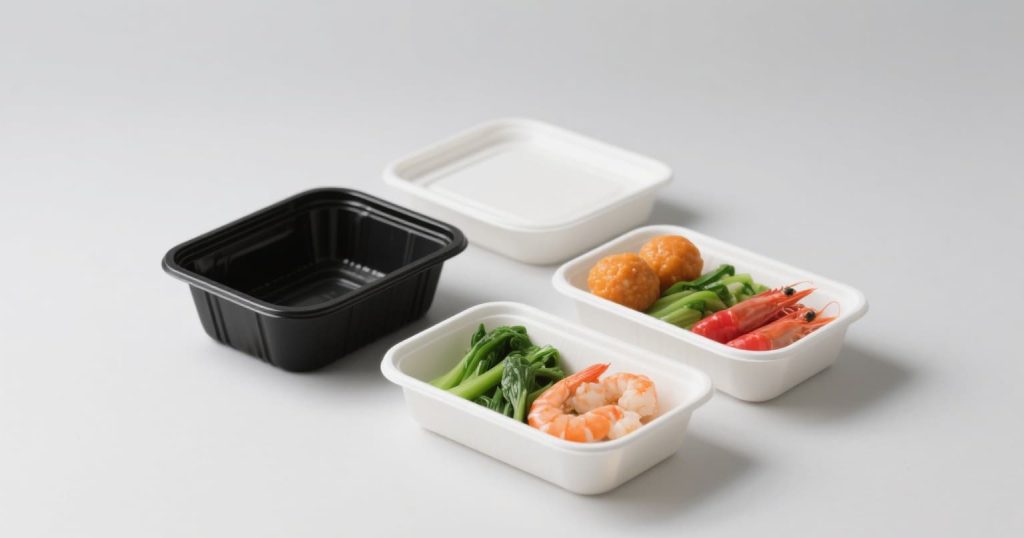
Comparing the Key Properties of These Materials
1. Durability
PET, rPET, and CPET are known for their strength and durability. These materials are resistant to breaking or cracking under pressure, making them ideal for food packaging that needs to withstand transportation, handling, and storage. This makes PET and rPET excellent choices for beverages and ready-to-eat meals that need to be transported long distances without compromising quality.
On the other hand, PLA is more fragile compared to PET and CPET. It is not as resistant to impact and may break or crack if mishandled. However, PLA is still suitable for lighter foods like salads, fresh fruit, and snacks that are not subjected to harsh handling.
2. Temperature Resistance
CPET has a clear advantage in terms of heat resistance. Unlike PET and rPET, CPET can withstand high temperatures without warping, which makes it suitable for packaging microwavable and oven-safe meals. CPET is ideal for food packaging that needs to be reheated or stored in high-temperature environments.
PET and rPET, while durable, are not designed for high-temperature applications. They are typically used for cold or ambient temperature foods and cannot withstand the extreme heat that CPET can.
PLA, on the other hand, has a lower melting point compared to PET and CPET. PLA containers can become soft or deformed if exposed to high temperatures, making them unsuitable for products that need to be heated in a microwave or oven.
3. Recyclability and Sustainability
PET and rPET are both recyclable plastics, and rPET is particularly popular for its environmental benefits, as it reduces the need for virgin plastic. rPET is often used in packaging for food and beverages, as it helps close the loop in the recycling process. However, PET and rPET are still plastics and may contribute to plastic waste if not properly recycled.
PLA, being made from renewable resources, is biodegradable and compostable, which makes it an attractive option for businesses looking to reduce their environmental footprint. However, PLA requires industrial composting conditions to break down completely, which are not available everywhere. In areas without access to composting facilities, PLA may not degrade as intended and could contribute to landfill waste.
While CPET is not biodegradable, it is recyclable in some regions, and its strength and durability make it suitable for reusing multiple times in some packaging applications.
4. Cost
The cost of PET, rPET, CPET, and PLA varies based on the production process and material properties. PET and rPET are generally cost-effective, making them a popular choice for mass-produced food packaging. The availability of rPET from recycled materials also helps reduce material costs.
PLA is typically more expensive to produce compared to PET and rPET due to the renewable resources required in its production. This higher cost can be a barrier for some businesses, especially in regions where the demand for sustainable packaging is not as high.
CPET, due to its specialized nature (heat resistance), is typically more expensive than PET and PLA, but it is still a popular choice for applications that require high-temperature performance, such as ready-to-heat meals.
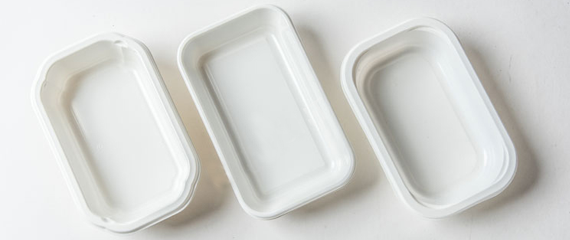
Which Material is Best for Different Types of Food Packaging?
PET and rPET: Best for Bottles and Cold Food Packaging
PET and rPET are ideal for beverages such as bottled water, soft drinks, and juices, as well as cold food packaging. Their clarity makes it easy for consumers to see the product inside, and their strength ensures that the product remains intact during handling and transport. These materials are commonly used in bottles, trays, and containers for fresh produce, dairy products, and packaged meals that do not require heating.
CPET: Best for Ready-to-Eat and Microwavable Meals
CPET is perfect for ready-to-heat meals, especially those that require reheating in a microwave or oven. CPET trays are often used for takeaway food containers, frozen meals, and microwavable food packaging because of their heat resistance and ability to withstand high temperatures. Its ability to keep food separated and protected while retaining heat makes it a top choice for pre-packaged meals in the foodservice industry.
PLA: Best for Eco-Friendly Food Service Packaging
PLA is an excellent choice for businesses that prioritize sustainability. PLA containers are often used for takeout packaging, single-use cups, plates, and bowls in food service. This material is especially popular in eco-conscious restaurants, food trucks, and catering services, as it is compostable and derived from renewable resources.


The Future of Food Packaging: Trends and Innovations
As the demand for sustainable packaging continues to grow, the food packaging industry is seeing innovations across various materials. PLA is likely to continue gaining popularity as businesses move towards biodegradable and compostable options, particularly for single-use packaging.
Meanwhile, rPET and PET will remain strong contenders, as advancements in recycling technologies improve the efficiency and cost-effectiveness of these materials. The use of recycled materials in food packaging is expected to increase, as businesses strive to meet consumer demand for eco-friendly products.
CPET, with its heat-resistant properties, is expected to remain essential for microwavable and oven-safe meals, as consumer convenience continues to be a priority in the food packaging sector.
FAQ
-
What is the main difference between rPET and PET?
rPET is made from recycled PET plastic, reducing the need for virgin plastic and making it a more eco-friendly option. Both materials share similar properties like durability and clarity, but rPET helps close the recycling loop, contributing to sustainability. -
Can PLA be used for hot food packaging?
PLA is not suitable for hot food packaging because it has a low melting point and may deform when exposed to high temperatures. It is best used for cold food packaging or single-use items like cups and plates. -
Is CPET recyclable?
Yes, CPET is recyclable in certain regions. While not biodegradable, it is highly durable and can be reused in packaging applications, making it a sustainable option for foodservice providers, especially those offering ready-to-heat meals. -
Why is PLA considered eco-friendly?
PLA is made from renewable resources like cornstarch or sugarcane, and it is biodegradable and compostable. However, it requires industrial composting conditions to break down fully, which may not be available everywhere, limiting its effectiveness in certain regions.
Conclusion: Choosing the Right Material for Your Food Packaging Needs
When choosing the best material for food packaging, it’s important to consider the type of food, storage needs, sustainability goals, and cost constraints. PET and rPET offer excellent durability and are ideal for cold food and beverages, while CPET is the best choice for heat-resistant packaging. PLA is a sustainable alternative for businesses focused on eco-friendly solutions, but its limitations in heat resistance may restrict its use for certain types of food.
As the food packaging industry continues to evolve, understanding the strengths and weaknesses of each material will help businesses make more informed decisions. Whether it’s for convenience, sustainability, or food safety, the right packaging material can make a significant impact on both the business and consumer experience.
References
-
NatureWorks – PET Packaging Sustainability
NatureWorks provides in-depth information about the sustainability and recycling of PET packaging materials.
https://www.natureworksllc.com -
ASTM D6400 – Standard Specification for Compostable Plastics
This standard from ASTM defines the criteria for compostable plastics, including PLA and its compostability requirements.
https://www.astm.org/ -
European Bioplastics – The Role of PET in Sustainable Packaging
European Bioplastics outlines how PET contributes to sustainable packaging efforts and the importance of using recycled PET (rPET).
https://www.european-bioplastics.org -
BPI – Biodegradable Products Institute
BPI certifies compostable packaging materials, including PLA products, ensuring they meet compostability standards for food packaging.
https://www.bpiworld.org -
Sustainable Packaging Coalition
The Coalition provides valuable insights into sustainable packaging alternatives and how PET, PLA, and other materials impact the environment.
https://www.sustainablepackaging.org
Copyright Statement© 2025 Dashan Packing. All rights reserved.
This article is an original work created by the Dashan Packing editorial team.All text, data, and images are the result of our independent research, industry experience,and product development insights. Reproduction or redistribution of any part of this contentwithout written permission is strictly prohibited.
Dashan Packing is committed to providing accurate, evidence-based information andto upholding transparency, originality, and compliance with global intellectual property standards.


